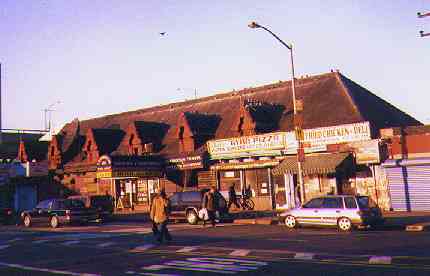The Bronx is the only mainland borough in New York City, and in the golden age of railroads it had plenty of freight and passenger routes that served upstate New York and New England. On this page, we’ll take a peek at one of those lines, the Harlem River Branch, which still has station houses waiting for trains that will never arrive again.
The southernmost extant station of the NY, NH & H is the Hunts Point station, on Hunts Point Avenue near the Bruckner Expressway. Most of the station is intact, including many of its peculiar architectural traits.
The Hunts Point station today is home to a variety of businesses… a deli, a pizza place, a travel agency, and a topless joint.
According to NYC subway and railroad historian Joe Brennan…
The New York, New Haven and Hartford made its entry to New York via the Harlem Line in 1849, but the secondary route known as the Harlem River Branch was opened in 1868 mainly to make freight connections by water with other railroads. Local passenger service was also run until 1931. The line was rebuilt in 1908-1910 to 6 tracks with complete grade separation, and all new stations. It was also electrified. Most of the branch became part of the Hell Gate Route opened in 1917, the main line from Penn Station to Boston, and so it still has intercity trains today run by Amtrak. The portion south of 142d Street is now open for freight only.
(Footnote: From 1876 to about 1906, two passenger trains a day on a Boston-Washington run were carried by lighter (a barge with rails) between the old Harlem River terminal and the Pennsylvania Railroad at Jersey City, without a New York station stop. That unusual operation was then replaced by an inland route over the Poughkeepsie Bridge, and the trains were finally included among those using the new Hell Gate route starting in 1917.)
Exterior and interior of Hunts Point when it was receiving passengers, probably until 1931. It had dormer windows and a crenelated roof. The roof spires and crenelation are now gone.
All older pictures on this page courtesy Joe Brennan.Photos from Roger Arcara’s ‘When the Westchester Was New’. They are from Railway Age Gazette, 28 January 1910, except the Hunts Point interior is from same, 4 February 1910.
The dormer windows are mainly haunted by pigeons these days, though one still has a window, and another still has a spire.
One of the features common to stations on the NY, NH & H that I saw was a diamond motif, which is repeated on the exteriors and interiors of the older pictures I was sent.
At Hunts Point, the diamonds on the exterior are all flanked by two stylized fish. I’m unsure why.
One of the modern uses for the Hunts Point station.
As it happens, the next station to remain standing is the very next stop on the NY, NH & H, the Westchester Avenue station at Whitlock Avenue and the Bronx River. Note the tiny piece of roof crenellation that has survived the years.
Westchester Avenue station in the 1910s. Most of the station house still stretches over the tracks as it did until passenger service was abandoned in 1931.
Westchester Avenue station dates to the late 1890s-early 1900s and features a lot of the ornamentation that marked public buildings at this time, with foliage, torches, wheels, and a mysterious target-like device.
The top of the stylized torches bear the letters NYH, which probably stand for New York and Hartford.
The station is still marked clearly. Surprisingly none of these metallic letters have fallen off over the decades.
(click for larger image)
Morris Park, at Sacket and Colden Avenues, has also had its canopy taken away in intervening years. Even when it was still in business, Morris Park was probably a pretty quiet station.
Note the diamond motif at what must have been the old ticket office.
Morris Park featured large picture windows. Of course they have long been bricked over and graffitied.
photo: Don Gilligan
There is one more abandoned station on the NY, NH & H in New York City, in the City Island Road station.
According to Brennan:
The brick stationhouse stands in ruins in the woods a short distance S of the road from the Hutchinson River Parkway to the City Island circle. It was also known as Bartow. This lonely spot was the transfer point for the trolley to City Island, which started here, so it rated a good station. To see it, start at the Pelham Bit Stables parking lot on the southbound Shore Road, and walk N along the bridle path. Just before the road to the Parkway, take an overgrown paved path W to the station. Warning: the bridle path is quite active; walk along the edge, but let horses and riders see you. Warning: the golf course parking lot to the north is a little closer to the station, but the walk requires a dangerous crossing of the road to the Parkway. At the station, please do not go onto the tracks: high speed Amtrak trains approach around curves from both sides.
Christopher Gray reviews the stations in this November 27, 2009 NY Times article.
3/1/01




